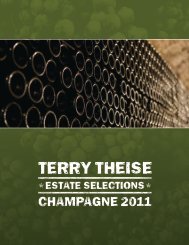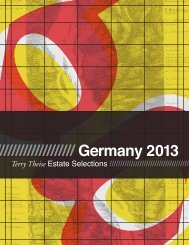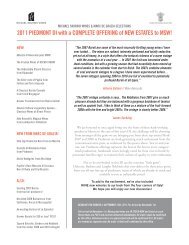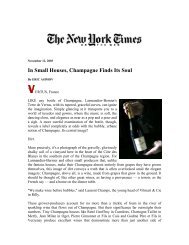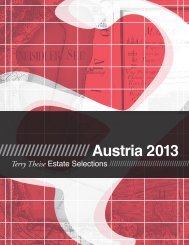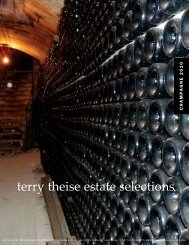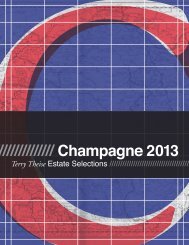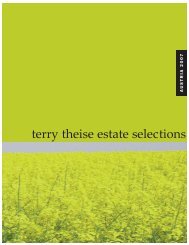German Catalog 2006 USE THIS ONE.qxp - Michael Skurnik Wines
German Catalog 2006 USE THIS ONE.qxp - Michael Skurnik Wines
German Catalog 2006 USE THIS ONE.qxp - Michael Skurnik Wines
You also want an ePaper? Increase the reach of your titles
YUMPU automatically turns print PDFs into web optimized ePapers that Google loves.
12<br />
Principles of Selection in this Portfolio<br />
Visit everyone, taste everything, select what I liked<br />
the best, and then tell why. Nothing new or revolutionary.<br />
The old broker-system is as good as dead now, and<br />
most of you don’t remember it anyway. The marketing of<br />
<strong>German</strong> estate wines has at last aligned with their smallbatch<br />
production structure.<br />
My own portfolio is slowly changing to reflect<br />
changes on the “scene” and amongst the growers.<br />
Generations change, a few people coast on auto-pilot as<br />
they get older, new ones come along. I want to be loyal to<br />
my growers, and I’m fond of many of them and friends<br />
with quite a few. It always hurts to cut an estate, but the<br />
person most deserving of my loyalty is you, dear reader<br />
and customer.<br />
At first I was deliberately ecumenical. I wanted to<br />
show you many facets of <strong>German</strong> wine and many differ-<br />
ent ways for it to be good. I still do. I am fond of the quirky.<br />
But I’m also realistic about how the wines are sold.<br />
You can’t visit each estate one-at-a-time like I do.<br />
Such visits have advantages and disadvantages. You see<br />
the wines in context, as they should be seen. But you<br />
don’t see them in what Bob Parker likes to call “peergroup”<br />
conditions; i.e., with a bunch of similar wines<br />
from other growers. We show the wines in portfolio tastings<br />
wherein a big ol’ slew of wines are lined up to be<br />
tasted alongside one another, exactly contrary to how<br />
they should be tasted or to any aims their makers had for<br />
them. But what choice do we have?<br />
The results are predictable. Some wines “show” better<br />
than others. Fragrant wines with lots of primary fruit.<br />
Spritzy wines. Even (ulp) sweeter wines. If your wine<br />
has quirks or tics, if it’s asymmetrical, earthy and ornery,<br />
it will be laid to waste in “peer-group” tastings. (What<br />
actual consumer ever says “Let’s see, tonight we’re having<br />
a big greasy pizza: let’s line up sixty-two Chianti<br />
Classicos and see how they ‘show’!”)<br />
From a zenith of over SIXTY growers this little family<br />
has been reduced to barely under forty, and it might have<br />
gone down as far as it should go. Demand is rising and one<br />
remains alert to the eventual demise of estates with no visible<br />
heirs. Plus I’m a curious cuss and don’t want to sit in<br />
my house with the windows closed. It may look quixotic to<br />
add agencies to a portfolio already numbering more than<br />
forty, but I suspect many of us in the fine wine biz have to<br />
struggle to reconcile our aesthetics with what passes for<br />
“common sense” as, ahem, businesspersons. For me, unless<br />
the businessman’s point is beyond argument, the aesthete<br />
usually prevails. Somebody has to hurl beauty in the wan<br />
face of common sense, and it might as well be me!<br />
Selecting was easier in the old days. <strong>German</strong> wine was<br />
unpopular and therefore inconspicuous, and it was a<br />
buyer’s market. I was at liberty to take only what I wanted.<br />
These days, we’re selling more and are therefore more consequential<br />
to the grower; if I pass on a certain wine it can<br />
play havoc with his plans. And bruise his ego. It’s all very<br />
Realpolitik, I suppose, and I sometimes wonder why I care<br />
so much about my precious “standards,” but always I<br />
come to the same answer. It’s because I want to keep faith<br />
with you. We may disagree, you and I, we may not like the<br />
same wines, but you deserve to know that I like what I say<br />
I like, and I won’t ask you to buy a wine I don’t endorse.<br />
But how do I reconcile this with the political need to<br />
placate a grower?<br />
There are certain wines with what I’d call iconic<br />
status. These wines belong in the market so you can<br />
make up your own mind about them. There are other<br />
wines with which I have some small aesthetic cavil or<br />
other, some minor but discernible imperfection which<br />
might bother me more than it would you. If the wine is<br />
otherwise worthy, you should see it.<br />
Thus I will make certain wines available which I do<br />
not in fact select. These wines will not have my name on<br />
the label, and will be clearly identified within this text.<br />
Bear in mind I’m not trying to create a lower-class of<br />
Theise-rejects. Yucky wine is simply yucky wine and<br />
you’ll never be offered it from me in any form. I am<br />
merely allowing you access to important wines with<br />
either iconic status or with minor imperfections, and<br />
identifying these wines for you.<br />
A CAUTIONARY NOTE: one thing I will not do is<br />
to try and seduce agencies from competing portfolios. It<br />
isn’t right and it isn’t even necessary. This year’s Gault<br />
Millau guide—a kind of classification of estates updated<br />
annually—shows nearly 150 estates of “classifiable”<br />
quality in the most important six regions AL<strong>ONE</strong> who<br />
have no American importer. Most of my competitors are<br />
honorable people. One dude has been paying heavy<br />
court to a number of estates in my portfolio. When he<br />
can’t get the wines he sometimes gray-markets them. I’m<br />
tempted to call such behavior evil, but it isn’t. It’s just<br />
pathetic. Still, the man has taste!




